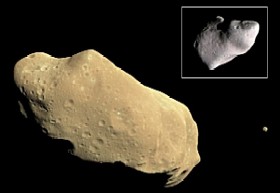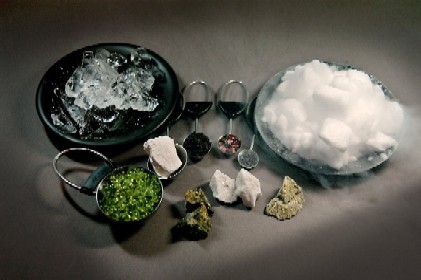Space Glossary

This page provides explanations and images of bodies throughout the universe: galaxies, solar systems, planets, nebula, stars, asteroids, comets, quasars, black holes, and more.
Asteroid

This image is of the asteroid Ida and its small satellite, Dactyl. Dactyl is the small object on the right, and in the close-up.
Asteroids, also known as the minor planets, are small bodies orbiting the Sun that resemble planets. More than 5,000 asteroids have been discovered, and most are found between Mars and Jupiter. Usually having an irregular shape, asteroids—at least those discovered thus far—can range in size from 580 miles (940 km) in diameter, which is the size of the asteroid Ceres, to just 33 ft. (10 m) in diameter.
Black Hole

Two computer generated images highlighting the star field called Orion's Belt as it appears in normal space (left) and how it would look if a black hole was present. Notice in the left image the three bright stars making up the "belt". Now, look at the right image with the black hole; it's strong gravity bends light toward it, causing unusual visual distortions.
A black hole is created by the total gravitational collapse of a massive star or group of stars. It is the final phase of some stars, in which gravity sucks the star in on itself—it implodes rather than explodes. This makes it so dense that not even light can escape its gravitational field.
Brown Dwarf

The approximate size of brown dwarf TWA 5B (center) compared to Jupiter (right) and the Sun (left). TWA 5B is estimated to be between 15 and 40 times the mass of Jupiter, making it one of the least massive brown dwarfs known.
Brown Dwarfs are also called failed stars. They lack enough energy to be true stars but are also too massive and hot to be planets.
Although brown dwarfs are similar in size to Jupiter, they are much denser and produce their own light whereas Jupiter shines with reflected light from the Sun.
Comet

Ingredients of a comet: clays; iron-containing compounds; carbonates, which are the minerals in seashells; crystallized silicates, such as the green olivine minerals found on beaches and in the gemstone peridot; polycyclic aromatic hydrocarbons, which are carbon-containing compounds found in car exhaust and on burnt toast; water vapor and carbon dioxide.
Comets are made up of frozen dust and gases, and have been described as large, dirty snowballs with icy centers. They often travel on extremely elongated orbits around the Sun. Some comets have orbits that take just 10 years to circumnavigate while other comets have orbits that take hundreds of thousands of years to circulate. The tail of a comet, called a coma, forms when the comet comes within 100 million miles of the Sun. It is then affected by the solar wind (hydrogen and helium that travel away from the Sun at high speeds), which causes a tail of dust and gases to form behind the comet.
Galaxy

The Whirlpool Galaxy, also called M51, is 37 million light-years away.
Galaxies are immense systems containing billions of stars. Astronomers have estimated that the universe could contain 40 to 50 billion galaxies. Galaxies have different shapes: some are spiral, others are elliptical, or oval-shaped, and some are irregular.
Meteor

This is the Barringer meteor crater in Arizona, the impact occurred 49,000 years ago. More than 100 impact craters have been identified worldwide.
Meteors are fragments of comets, planets, moons, or asteroids that have broken off. It is estimated that a billion meteors enter our atmosphere every day. Contact with our atmosphere causes most to disintegrate before reaching Earth. Those that do not disintegrate completely but fall to Earth are called meteorites.
Milky Way

Notice the location of our Sun in the Milky Way Galaxy, indicated on the lower portion of the picture.
The Milky Way is our own galaxy. Just about all that you can see in the sky belongs to our galaxy—a system of roughly 200 billion stars. The Milky Way is a spiral-shaped galaxy about 100,000 light-years in diameter and about 10,000 light-years in thickness.
Nebula

This nebula is called NGC 3132. At the center are two stars, one dim and one bright. The dim star is the dying one that ejected the gases forming the nebula. The bright star is younger, but will likely create a similar type of nebula upon its death. The gas expanding from the dying star is over half a light-year wide (about 2,935,686,240,000 miles), moving away from the central star at a speed of 9 miles per second.
A nebula is a giant glowing cloud thought to be made up of dust and gas. Nebulae were thought to have been galaxies that appeared as a blur because they were so far away, but as more powerful telescopes were created, they showed that nebulae were not clumps of stars but in fact a hazy cloud of gasses. A nebula is illuminated by bright stars nearby. More than 300 nebulae have been named.
Neutron Stars
Neutron stars are formed after a supernova explodes and shrinks. The shrunken form of the star becomes incredibly dense and compact as gravity pulls all of its matter inward. It becomes so compressed that a million tons of its matter would hardly fill a thimble. This density crushes together the electrons and protons that make up its atoms, turning them into neutrons.
On December 27, 2004, a neutron star flared up so brightly, it temporarily blinded all the X-ray satellites in space for an instant, and lit up the Earth's upper atmosphere. This tremendous blast of energy was from a giant flare created by the neutron star's twisting magnetic field. Objects like this are called magnetars, and they produce magnetic fields trillions of time more powerful than those here on Earth. These fields are so strong they can actually buckle the surface of the neutron star causing these powerful star quakes.
Orbit

This diagram shows the relative size of the orbits of the seven planets visible to the naked eye. All the orbits are nearly circular (but slightly elliptical) and nearly in the same plane as Earth's orbit (called the ecliptic). The diagram is from a view out of the ecliptic plane and away from the perpendicular axis that goes through the Sun.
Orbit is the term for the path traveled by a body in space. It comes from the Latin orbis, which means circle. Some orbits are nearly circular, but the orbits of most planets are ellipses—shaped like ovals.
Planet

This image is of the planet Neptune.
Planet is the term used for a body in orbit around the Sun. The word comes from the Greek planetes, and means “wanderers.” Our solar system has eight planets: Mercury, Venus, Earth, Mars, Jupiter, Saturn, Uranus, and Neptune. Since 1994, evidence has been found that planets also exist beyond our solar system. At least 322 planets existing in other solar systems have been discovered.
Pulsars

These images are of the Vela pulsar and its jet of high energy particles. The jet is half a light year in length, and is shooting out ahead of the moving pulsar.
Pulsars are believed to be rapidly spinning neutron stars that give off bursts of radio waves at regular intervals. Pulsar is a shortened version of Puls[ating st]ar.
Quasars

This is an artist's concept of a quasar, or growing black hole, at the center of a distant galaxy. The quasar is the orange object at the center of the large, irregular-shaped galaxy. It consists of a doughnut-shaped cloud of gas and dust that feeds a central super massive black hole. As the black hole feeds, the gas and dust heat up and spray out X-rays, illustrated by the white rays.
Quasars (quas[istell]ar objects) are believed to be the most remote objects in the universe. Despite their small size they produce tremendous amounts of light and microwave radiation: not much bigger than Earth's solar system, they pour out 100 to 1,000 times as much light as an entire galaxy containing a hundred billion stars.
Satellite

Jupiter and its largest moon Ganymede (lower left).
Satellite (or moon) is the term for a body in orbit around a planet. As long as our own Moon was the only moon known, there was no need for a general term for the moons of planets. But when Galileo Galilei discovered the four main moons of the planet Jupiter, Johannes Kepler wrote Galileo a letter suggesting he call them “satellites” (from the Latin satelles, which means attendant). The word means the same thing as “moon.”
Solar System
Our solar system is made up of the Sun (solar means sun) at its center, the eight planets that orbit it, and the various satellites, asteroids, comets, and meteorites that are also controlled by the Sun's gravitational pull.
Stars

This image is of N49, the brightest supernova remnant, or stellar debris, in the Large Magellanic Cloud.
A supernova is an extremely large exploding star. Just before the star dies, it releases huge amounts of energy, briefly becoming millions of times brighter than it was. Then it immediately shrinks.
White Dwarf

Like a butterfly, a white dwarf star begins its life by casting off a cocoon that enclosed its former self. The above cocoon, the planetary nebular designated NGC 2440, contains one of the hottest white dwarf stars known. The white dwarf can be seen as the bright dot near the photo's center.
White dwarfs occur when a star runs out of energy and shuts down. The force of gravity at its center pulls the mass of the star in on itself, forcing it to collapse. It resembles the glowing cinders of a fire that has died down. It is called a white dwarf because it emits a white glow.
(All photos courtesy of NASA)
